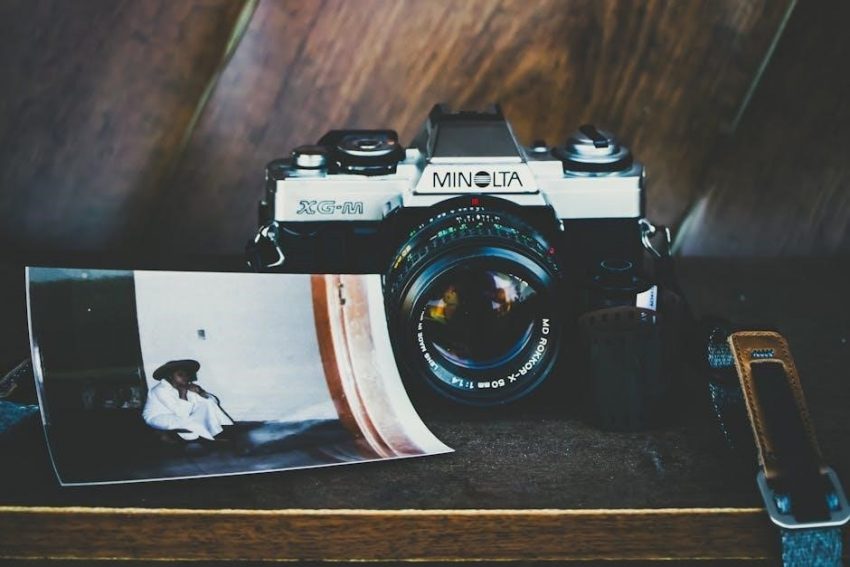The Minolta X-370 is a microcomputerized single-lens reflex (SLR) camera designed for ease of use and advanced photography. It features quartz-controlled mechanical sequences and offers aperture and shutter priority modes‚ making it ideal for both professionals and enthusiasts. This guide provides detailed instructions for optimal use and maintenance of the X-370.
Overview of the Minolta X-370 Camera
The Minolta X-370 is a microcomputerized single-lens reflex (SLR) camera designed for versatility and ease of use. It features aperture and shutter priority modes‚ offering precise control over exposure settings. With quartz-controlled mechanical sequences‚ it ensures accurate and reliable operation. The camera is suitable for both professional photographers and enthusiasts‚ providing a balance between advanced features and user-friendly design. Its compatibility with various lenses and accessories enhances its functionality‚ making it a popular choice for diverse photography needs.
Key Features and Specifications
The Minolta X-370 boasts a range of advanced features‚ including aperture priority‚ shutter priority‚ and manual modes. It offers a shutter speed range of 1/1000 to 4 seconds and a manual ISO setting from 12 to 3200. The camera’s built-in light meter ensures accurate exposure control‚ while its interchangeable lenses provide versatility. Additional features include a self-timer‚ mirror lock-up‚ and compatibility with external flash units. Constructed with durability in mind‚ the X-370 is a reliable choice for photographers seeking precision and adaptability in their work.
Importance of the Instruction Manual
The Minolta X-370 instruction manual is essential for understanding the camera’s advanced features‚ troubleshooting common issues‚ and optimizing its performance. It provides detailed guidance on aperture and shutter priority modes‚ manual controls‚ and proper maintenance. The manual also includes safety precautions and tips for achieving the best results in various photography scenarios. By following the instructions‚ users can unlock the camera’s full potential‚ ensure longevity‚ and enhance their overall photography experience. Referencing the manual regularly helps users master the X-370’s capabilities and address any challenges effectively.
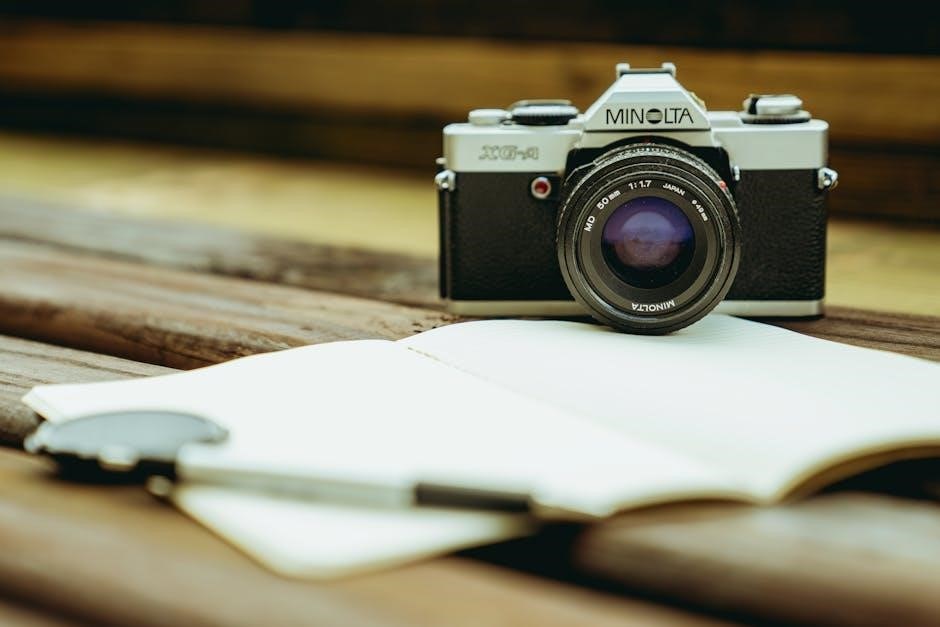
Components of the Minolta X-370
The Minolta X-370 features a durable exterior with intuitive controls‚ a high-quality lens mount‚ and advanced internal mechanisms‚ including a precise shutter system and electronic circuits.
Exterior Parts and Controls
The Minolta X-370 features a sturdy exterior with a user-friendly layout. Key components include the mode dial‚ shutter speed dial‚ and aperture ring. The camera has a built-in flash‚ a hot shoe for external flash units‚ and a self-timer lever. The lens mount supports a wide range of compatible lenses‚ while the viewfinder provides clear visibility for framing shots. Additional controls like the ISO dial and exposure compensation button are strategically placed for easy access. The camera’s ergonomic design ensures comfort during extended use‚ with a durable build that withstands regular photography sessions.
Interior Mechanisms and Electronics
The Minolta X-370’s interior features a microcomputerized system controlling its operations. Quartz precision regulates the shutter and mechanical components‚ ensuring accurate exposures. Advanced electronic circuits manage metering‚ autofocusing‚ and flash synchronization. The camera’s internal mechanisms are designed for durability and reliability‚ with a focus on seamless integration between hardware and software. These components work together to deliver consistent performance‚ making the X-370 a dependable tool for photographers seeking precise control over their craft. The electronics are shielded to minimize interference‚ ensuring optimal functionality in various shooting conditions. This robust design underscores the camera’s reputation for reliability and versatility in both casual and professional photography settings.
Lens Compatibility and Accessories
The Minolta X-370 is compatible with lenses featuring the Minolta SR mount system‚ offering versatility for various photography needs. It supports a wide range of lenses‚ including standard‚ wide-angle‚ telephoto‚ and macro options; Additionally‚ the camera can be paired with accessories like external flash units‚ remote shutters‚ and lens hoods to enhance functionality. These accessories are designed to optimize performance and adaptability‚ catering to both casual and professional photographers. Compatibility with a broad array of optics and accessories ensures the X-370 remains a flexible and powerful tool for diverse shooting scenarios.
Loading Film and Battery Installation
The Minolta X-370 uses 35mm film and requires SR/LR44 batteries for operation. Film loading is straightforward‚ while battery installation ensures proper camera functionality and power management.
Step-by-Step Film Loading Process
Open the camera back by sliding the release latch. Insert the film canister‚ ensuring it clicks into place. Align the film leader with the spool‚ then gently pull it across the gate. Close the camera back securely. Advance the film by turning the rapid winding lever until it stops. Check the frame counter to confirm film advancement. Set the ISO using the dial on the lens or camera body. Your camera is now ready for use‚ ensuring proper film handling and optimal photography results.
Battery Types and Installation Guidelines
The Minolta X-370 requires two SR44 or LR44 silver oxide batteries for operation. Open the battery compartment on the camera base by sliding it forward. Insert the batteries‚ ensuring the positive (+) terminal faces upwards. Close the compartment securely. Use fresh batteries for optimal performance. Avoid mixing old and new batteries or using different types. Replace batteries every 12 months or when the built-in meter shows low power. Proper installation ensures accurate metering and reliable camera function. Always check battery expiration dates before installation for consistent performance.
Ensuring Proper Camera Power-Up
After installing the batteries‚ ensure the camera powers up correctly. Turn the mode dial to any shooting mode. The camera will perform a self-test‚ indicated by the front LED blinking once. If the LED does not blink‚ check battery installation and ensure they are fresh. Avoid using old or mixed battery types. The camera’s microcomputer will initialize‚ preparing it for operation. Proper power-up ensures accurate exposure control and functionality. If issues persist‚ refer to the troubleshooting section for further guidance. Always wait for the LED confirmation before taking photos to ensure optimal performance.
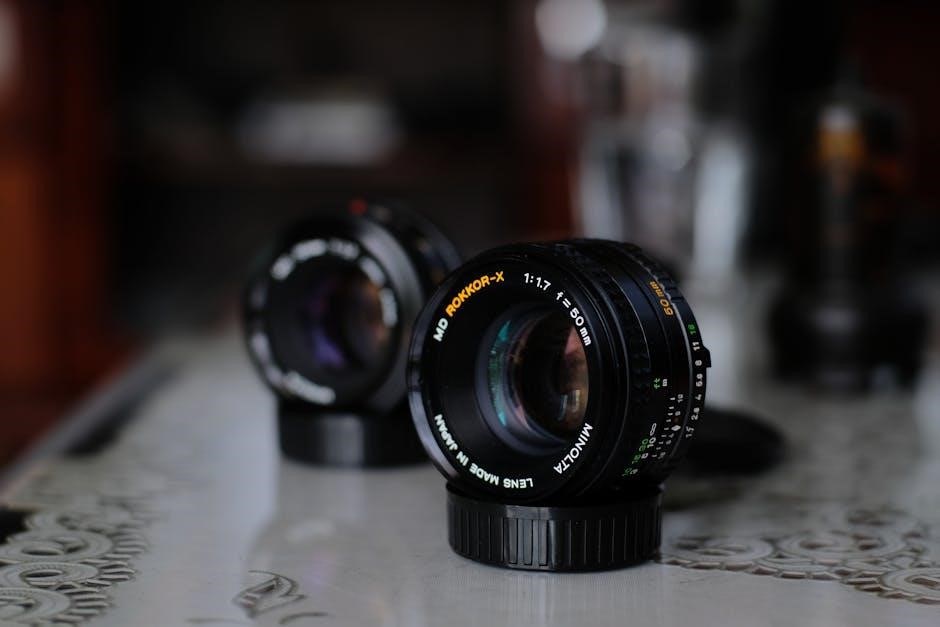
Basic Camera Operation
The Minolta X-370 offers intuitive controls for aperture‚ shutter speed‚ and ISO settings. Use the built-in light meter for accurate exposure readings‚ ensuring optimal image capture.
Understanding Aperture‚ Shutter Speed‚ and ISO
The Minolta X-370 allows precise control over aperture‚ shutter speed‚ and ISO. Aperture regulates light entry through the lens‚ with lower f-stops for more light. Shutter speed controls exposure duration‚ affecting motion blur. ISO sets sensitivity to light‚ with lower values for bright conditions and higher for low light. Together‚ these elements enable creative control over image exposure and quality‚ making the X-370 versatile for various photography scenarios.
Setting the Correct Exposure
Setting the correct exposure on the Minolta X-370 involves balancing aperture‚ shutter speed‚ and ISO. Use aperture priority mode to adjust the aperture‚ with the camera automatically setting the shutter speed. In manual mode‚ control both aperture and shutter speed. The built-in light meter provides accurate readings‚ with options for spot‚ center-weighted‚ or average metering. Adjust exposure compensation to fine-tune settings in challenging lighting conditions. Bracketing shots at different exposures ensures optimal results in varying lighting scenarios.
Using the Built-in Light Meter
The Minolta X-370 features a built-in light meter for accurate exposure readings. It supports spot‚ center-weighted‚ and average metering modes. Spot metering focuses on a specific area‚ while center-weighted emphasizes the central part of the frame. Average metering calculates exposure across the entire scene. Activate the meter by pressing the shutter release halfway. The display shows exposure values‚ allowing adjustments to aperture‚ shutter speed‚ or ISO. Use the metering mode selector to choose the appropriate mode for your scene. Proper use ensures well-balanced exposures in various lighting conditions.
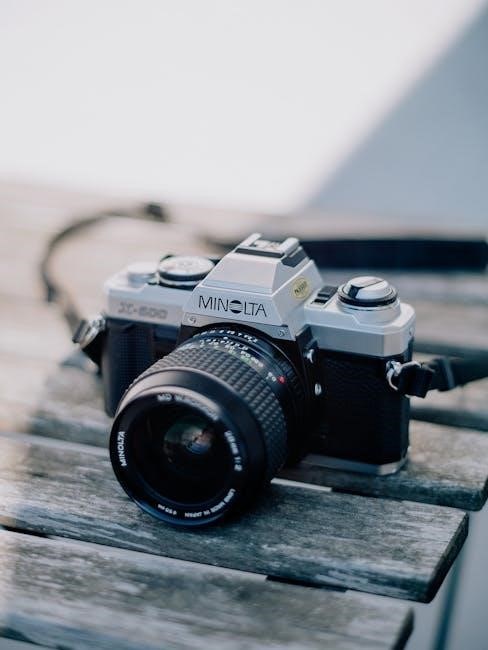
Advanced Shooting Modes
The Minolta X-370 offers Manual‚ Aperture Priority‚ and Shutter Priority modes for precise control. Manual mode allows full customization‚ while aperture and shutter priority modes automate specific settings.
Manual Mode Operation
Manual Mode on the Minolta X-370 offers full control‚ allowing photographers to set both aperture and shutter speed. Users can adjust these settings to achieve desired creative effects. The camera’s light meter guides exposure adjustments. Proper use ensures precise control over lighting‚ depth of field‚ and motion capture. This mode is ideal for experienced photographers seeking customization. Refer to the manual for detailed steps on operating Manual Mode effectively. Proper technique ensures optimal results in various shooting conditions‚ enhancing your photography skills and creativity. Always consult the manual for specific instructions.
Aperture Priority Mode
Aperture Priority Mode (A mode) on the Minolta X-370 allows photographers to set the desired aperture‚ while the camera automatically adjusts the shutter speed for proper exposure. This mode is ideal for controlling depth of field‚ enabling creative effects like blurred backgrounds or sharp landscapes. To use A mode‚ set the aperture using the lens aperture ring‚ and the camera will adjust the shutter speed accordingly. The built-in light meter ensures accurate exposure‚ guiding adjustments for optimal results. This mode is perfect for photographers who prioritize depth of field while maintaining ease of use. Always refer to the manual for precise instructions.
Shutter Priority Mode
Shutter Priority Mode (S mode) on the Minolta X-370 enables photographers to set the shutter speed manually‚ allowing the camera to adjust the aperture for proper exposure. This mode is ideal for capturing motion effects‚ such as freezing fast-moving subjects or creating motion blur. To use S mode‚ set the desired shutter speed using the shutter speed dial. The camera will automatically adjust the aperture to ensure correct exposure. This mode is particularly useful for sports‚ action‚ or low-light photography. Refer to the manual for detailed instructions and optimal results.
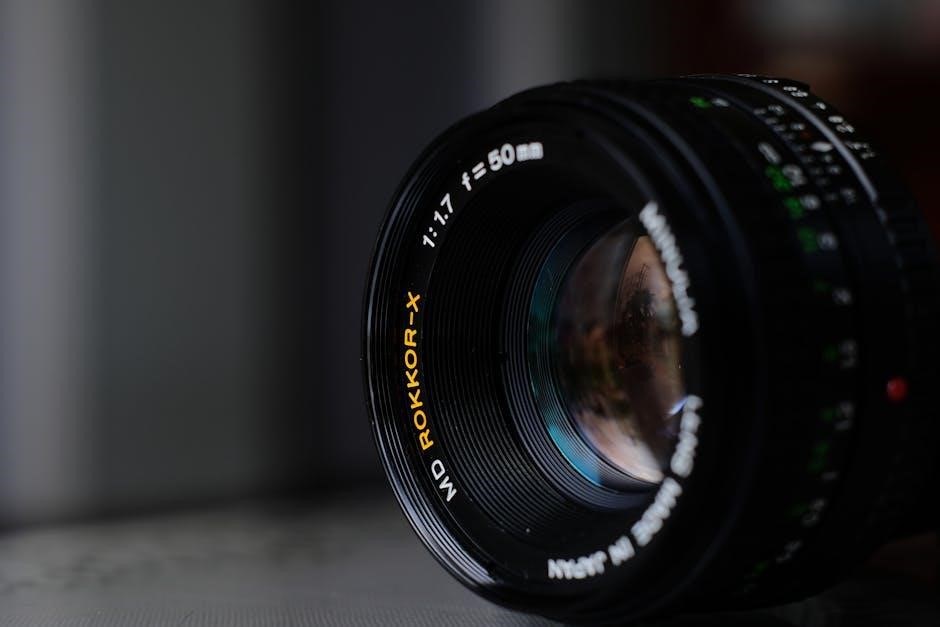
Focusing Techniques
The Minolta X-370 offers precise focusing options‚ including manual focus for creative control and autofocus for quick‚ accurate subject capture. Use focus lock to maintain focus on stationary subjects.
Manual Focusing
Manual focusing on the Minolta X-370 allows precise control over focus by rotating the focusing ring on the lens. This method is ideal for selective focus or when autofocus is unreliable. To use manual focus‚ switch the lens to MF mode and adjust the ring until your subject is sharp. Use the viewfinder’s focusing screen for accurate framing. The camera also features focus lock‚ enabling you to lock focus on a subject and recompose the shot. This technique is particularly useful for portraits‚ macro photography‚ or when shooting through obstacles.
Autofocus Operation
The Minolta X-370 features a reliable autofocus (AF) system for quick and accurate focusing. To use AF‚ align your subject within the viewfinder’s AF frame and press the shutter button halfway. The camera will emit a beep and display a green LED in the viewfinder once focus is achieved. For moving subjects‚ continuous AF tracking can be activated by keeping the shutter button pressed. If the subject moves out of the AF frame‚ focus lock can be used to maintain sharpness. While AF is fast and precise‚ manual focus may still be preferred in low-light conditions or for creative control.
Using Focus Lock
Focus lock on the Minolta X-370 allows you to maintain focus on a subject even when it moves out of the AF frame. Press the shutter button halfway to activate autofocus‚ then press it again to lock focus. This feature is especially useful for off-center compositions or when shooting through obstacles. Once locked‚ you can recompose the shot without losing focus. For optimal results‚ ensure the subject remains within the frame and adjust as needed. Focus lock enhances control‚ enabling precise focusing in various shooting scenarios.
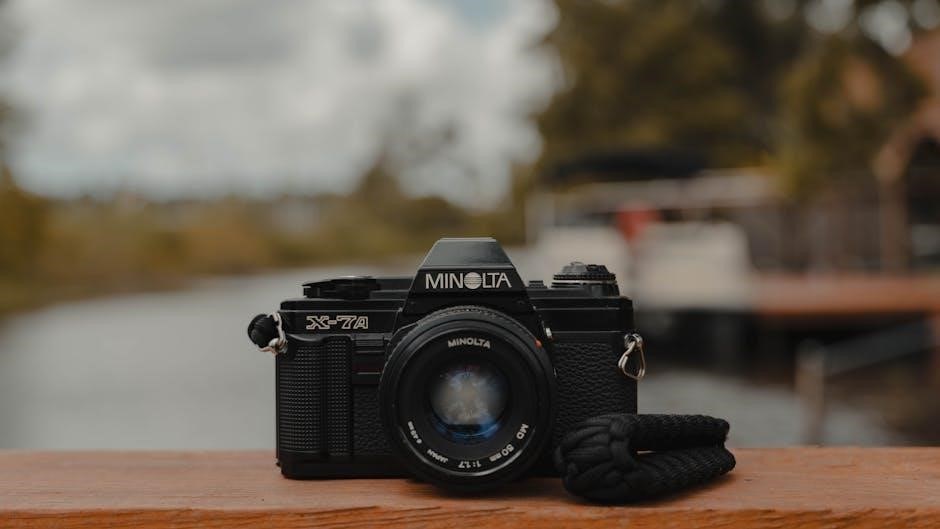
Exposure Control
The Minolta X-370 offers precise exposure control through aperture‚ shutter speed‚ and ISO adjustments. Features include exposure compensation‚ bracketing‚ and metering modes for optimal image capture in various lighting conditions.
Exposure Compensation
Exposure compensation allows adjustments to the camera’s metered exposure‚ enabling photographers to fine-tune brightness. On the Minolta X-370‚ this feature is accessible via the exposure compensation dial‚ offering a range of ±2 stops in 1/3-stop increments. This adjustment is particularly useful in challenging lighting conditions‚ such as backlit scenes or high-contrast environments. When activated‚ the compensation is applied to both manual and aperture/shutter priority modes‚ ensuring creative control over image exposure. Proper use of this feature enhances the accuracy of your shots‚ delivering well-balanced results in diverse photographic situations.
Bracketing Shots
Bracketing shots on the Minolta X-370 allows photographers to capture multiple exposures of the same scene at different settings. This technique is useful for achieving the perfect exposure in high-contrast lighting conditions. The camera can be set to bracket exposures automatically‚ capturing up to three frames at preset intervals. Users can adjust the bracketing range and the number of shots to suit their needs. This feature is particularly handy for capturing images intended for HDR processing or when shooting in challenging lighting environments where precise exposure control is critical.
Using the Metering Modes
The Minolta X-370 offers multiple metering modes to ensure accurate exposure control. The camera features spot metering for precise measurements of specific areas‚ center-weighted metering for balanced exposures‚ and matrix metering for advanced scene analysis. Spot metering is ideal for high-contrast scenes‚ while center-weighted metering prioritizes the central part of the frame. Matrix metering evaluates the entire scene‚ adjusting for optimal results. Users can select the mode that best suits their composition‚ ensuring well-exposed images in varying lighting conditions. This versatility enhances creative control and improves photographic outcomes.
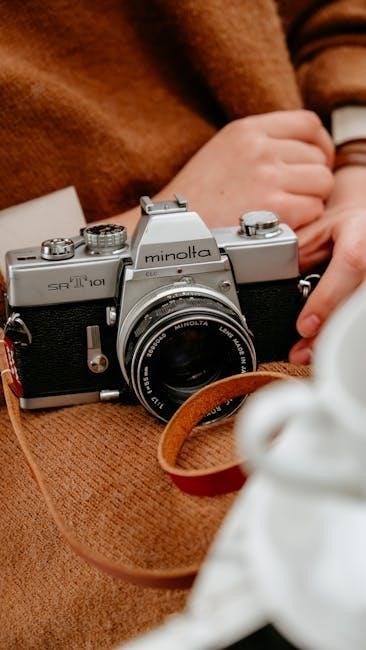
Flash and External Accessories
The Minolta X-370 supports a built-in flash and compatibility with external flash units for enhanced lighting control. It also accommodates various accessories‚ expanding its functionality for diverse photography needs.
Using the Built-in Flash
The Minolta X-370 features a built-in flash for convenient lighting in low-light conditions. The flash automatically activates when needed‚ with dedicated flash functions that electronically set the camera for proper exposure. It operates in sync with the camera’s shutter‚ ensuring balanced illumination. Users can adjust flash output based on ISO settings and scene requirements. The built-in flash is ideal for casual and professional photography‚ providing reliable lighting without the need for external units. Always refer to the manual for specific flash operation guidelines and synchronization settings.
Connecting External Flash Units
To enhance lighting capabilities‚ the Minolta X-370 supports external flash units. These flashes are designed with dedicated functions‚ ensuring proper synchronization and exposure. Connect the flash via the hot shoe or sync cable for seamless operation. Always refer to the flash unit’s manual for specific settings. Ensure the flash is compatible with the X-370 to avoid malfunctions. Proper synchronization is crucial for optimal results. For advanced control‚ adjust flash power settings according to the scene’s requirements. This feature allows photographers to achieve professional-grade lighting in various conditions.
Compatible Accessories
The Minolta X-370 supports a variety of accessories to enhance its functionality. Compatible lenses include Minolta’s MD and MC mounts‚ ensuring versatility in photography. The Program Back P allows for advanced data recording‚ while remote controllers enable hands-free operation. Additionally‚ the Tripod A provides stability for long exposures. All accessories are designed to integrate seamlessly with the X-370‚ maintaining optimal performance. For detailed compatibility‚ refer to the official manual or manufacturer guidelines to ensure proper use of these accessories.
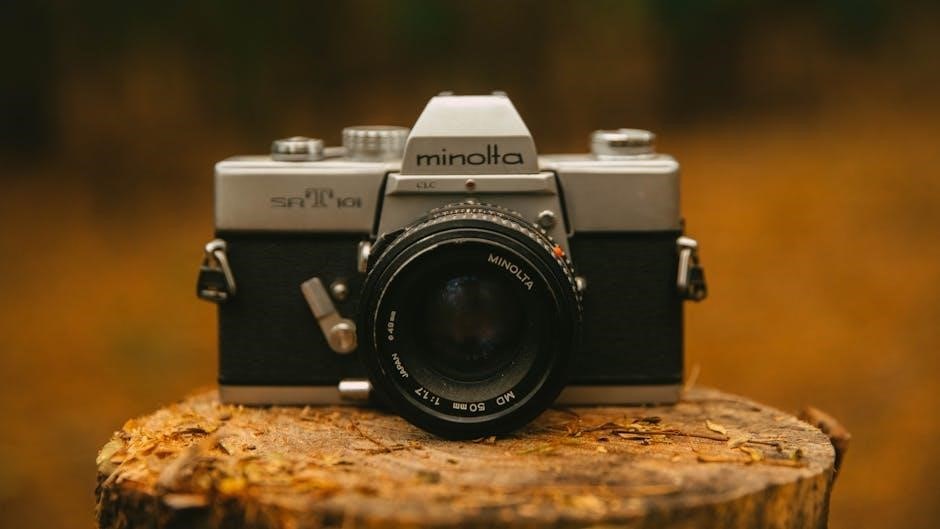
Camera Maintenance and Care
Regularly clean the camera and lens with soft cloths to prevent dust buildup. Avoid harsh chemicals and store in a dry‚ cool place. Inspect for damage and ensure all parts function smoothly for optimal performance.
Cleaning the Camera and Lens
Regular cleaning is essential to maintain the Minolta X-370’s performance. Use a soft‚ dry microfiber cloth to wipe the camera body and lens‚ avoiding harsh chemicals. For stubborn smudges‚ dampen the cloth slightly with distilled water. Never touch the lens surface with bare hands‚ as oils can leave residue. Use a lens brush to remove dust particles gently. Avoid using tissues or paper products‚ as they may scratch the lens. Clean the viewfinder and mirror regularly to ensure clear visibility. Store the camera in a protective case when not in use to prevent dust accumulation.
Storing the Camera Properly
Store the Minolta X-370 in a cool‚ dry place away from direct sunlight and moisture. Use a protective camera case to shield it from dust and physical damage. Ensure the camera is completely dry before storage to prevent mold. Remove the battery and store it separately to avoid corrosion. Detach the lens and attach lens caps to protect the glass. Avoid extreme temperatures or humid environments. Regularly inspect the camera and lens for signs of wear or damage during storage. Proper storage ensures long-term functionality and preserves image quality.
Regular Maintenance Tips
Regularly clean the camera and lens with a soft‚ dry cloth to prevent dust buildup. Inspect the battery contacts for corrosion and clean them gently if necessary. Store the camera in a cool‚ dry environment to avoid moisture damage. Check the lens for scratches or fungus and have it professionally cleaned if needed. Avoid exposing the camera to extreme temperatures or humidity. Lubricate moving parts only if specified in the manual. Use a lens cleaning solution for stubborn smudges. Ensure all components are dry before storage to prevent mold growth. Regular maintenance ensures optimal performance and longevity.
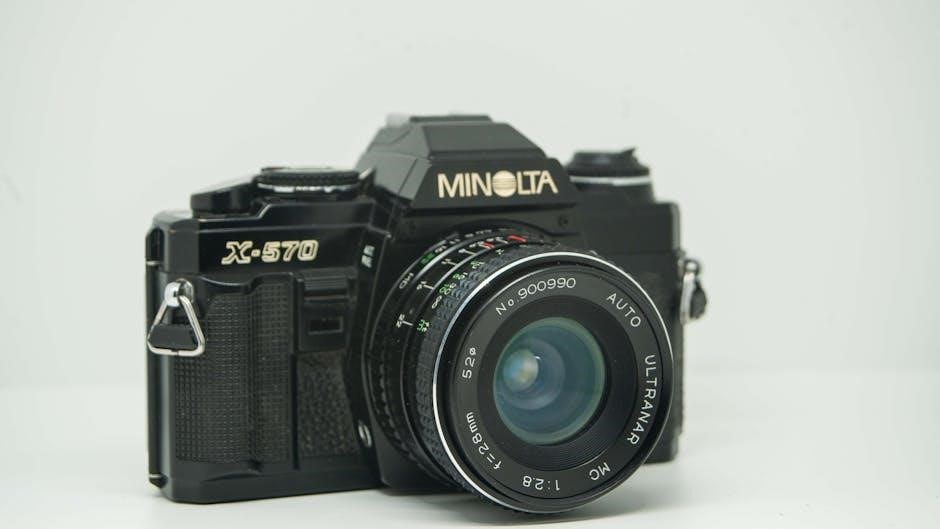
Troubleshooting Common Issues
Address common issues like shutter malfunctions‚ exposure errors‚ or autofocus problems by consulting the manual. Regular maintenance and proper handling often resolve these issues effectively.
Resolving Shutter Malfunctions
If the shutter fails to operate‚ ensure the battery is fully charged and properly installed. Clean the shutter curtains and internal mechanisms to remove dirt or debris. If issues persist‚ try resetting the camera or consulting the Minolta X-370 Service Manual for detailed repair guidance. For persistent problems‚ contact a professional technician or refer to the troubleshooting section in the manual for specific solutions‚ such as adjusting shutter tension or replacing faulty components.
Fixing Exposure Errors
To correct exposure errors‚ check the ISO‚ aperture‚ and shutter speed settings. Ensure the light meter is functioning correctly and adjust accordingly. If overexposure occurs‚ reduce the aperture or increase the shutter speed. For underexposure‚ do the opposite. Review the Minolta X-370 Instruction Manual for guidance on using exposure compensation and bracketing features to achieve balanced results. Regularly cleaning the camera’s sensors and ensuring proper film loading can also prevent exposure issues.
Addressing Autofocus Problems
If the autofocus fails to function properly‚ first clean the lens and camera sensors to ensure clear communication. Check the AF-MF switch on the lens‚ ensuring it’s set to AF mode. Verify the camera’s microcomputer by resetting it if necessary. Consult the Minolta X-370 Instruction Manual for detailed troubleshooting steps. If issues persist‚ inspect the lens and camera connections for damage or misalignment. For unresolved problems‚ consider professional repair to maintain optimal autofocus performance and image quality.
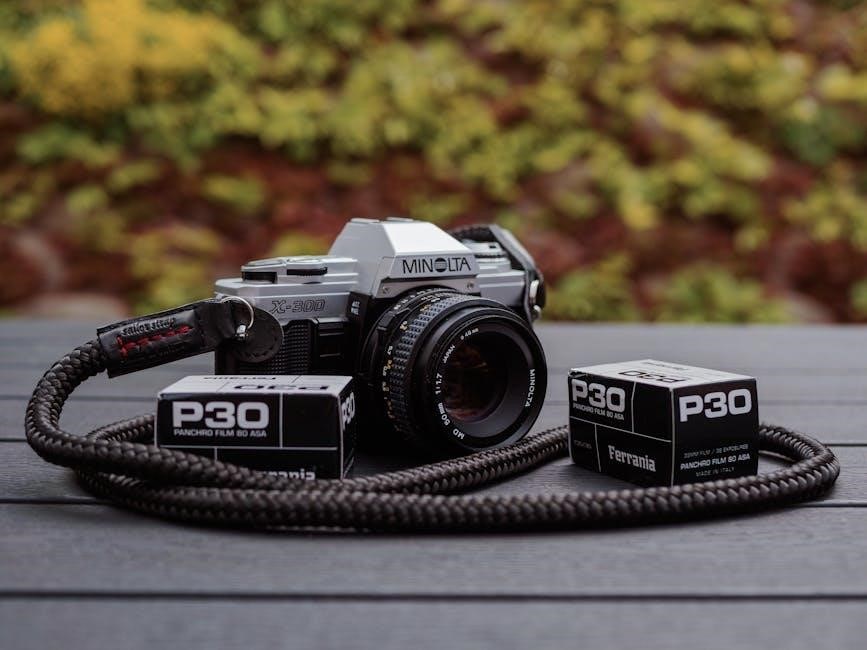
Service and Repair Information
For expert repairs‚ refer to the Minolta X-370 Service Manual PDF. It covers troubleshooting‚ maintenance‚ and professional repair options with detailed instructions for optimal performance.
Accessing the Service Manual
Accessing the Minolta X-370 service manual is straightforward. It is available as a free PDF download on platforms like ManualsLib and ManualsBase. This comprehensive guide provides detailed troubleshooting‚ maintenance‚ and repair procedures. Whether you’re a professional technician or a DIY enthusiast‚ the manual offers clear instructions to ensure optimal camera performance. Downloading the manual is a great way to keep your Minolta X-370 in top condition.
Professional Repair Options
For complex repairs or maintenance‚ professional repair services are recommended. Authorized service centers specializing in Minolta cameras offer expert diagnostics and genuine parts. Additionally‚ experienced technicians from companies like Konica Minolta provide reliable support. These professionals ensure your X-370 operates at peak performance‚ covering issues from shutter mechanisms to electronic components. Consulting a professional guarantees high-quality repairs‚ preserving your camera’s functionality and longevity.
DIY Repair Tips
For minor issues‚ DIY repair can be feasible with the right tools and knowledge. Cleaning the camera and lens is a simple yet effective maintenance task. Refer to the Minolta X-370 Service Manual for guidance on basic repairs‚ such as replacing light seals or adjusting shutter mechanisms. Ensure proper grounding to avoid static damage. For more complex fixes‚ consider consulting online forums or repair guides. However‚ always exercise caution‚ as improper repairs can cause irreversible damage. If unsure‚ professional assistance is recommended to maintain your camera’s performance and longevity.
The Minolta X-370 is a versatile‚ user-friendly SLR camera ideal for professionals and hobbyists. Its advanced features and durability make it a timeless choice for mastering photography techniques.
Final Tips for Optimal Use
For the best experience with your Minolta X-370‚ always clean the lens and camera body regularly to prevent dust interference. Use genuine Minolta accessories to ensure compatibility and performance. Experiment with aperture and shutter priority modes to enhance your photography skills. Familiarize yourself with the manual to unlock all features. Store the camera in a dry‚ cool place when not in use. Regularly check the battery and film for optimal functionality. By following these tips‚ you’ll maximize the camera’s potential and enjoy consistent‚ high-quality results in your photography journey.
Resources for Further Learning
To deepen your understanding of the Minolta X-370‚ explore its official instruction manual‚ available as a free PDF download. Websites like ManualsLib and Butkus Cameras offer comprehensive guides and repair manuals. Additionally‚ online forums and photography communities provide valuable insights and troubleshooting tips. For hands-on learners‚ YouTube tutorials and photography blogs dedicated to film cameras can enhance your skills. These resources will help you master the X-370 and unlock its full potential for capturing stunning images.

